-
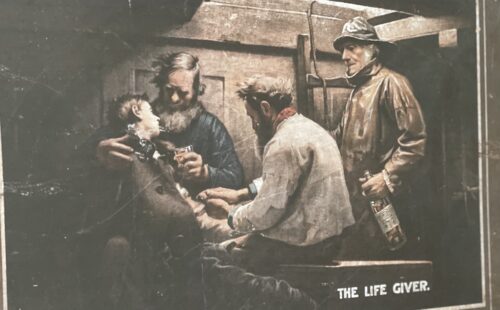
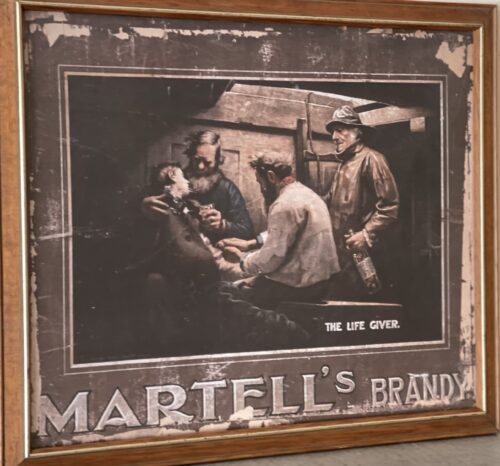 40cm x 34cm Limerick Martell is a Cognac house founded in 1715 by Jean Martell (1694–1753). It is part of the Martell Mumm Perrier-Jouët subsidiary of the French wines and spirits conglomerate Pernod Ricard. In 1715, Jean Martell, a young merchant originally from Jersey, created his own trading business at Gatebourse in Cognac, on the banks of the Charente, and thus founded one of the first cognac houses. Martell used grapes from the vineyards in the Borderie subregion, and used Tronçais oak for its casks, this made a combination that resulted in an exceptionally smooth cognac.After his death in 1753, his widow and then his two sons and grandson continued this tradition and developed the export business to make Martell the number one in England in 1814. In 1831, Martell created his first "VSOP" (Very Superior Old Pale) cognac and continued its international expansion. Its fame spread throughout the world, with the first exports to Japan and other Asian markets, such as Indonesia, Vietnam, Malaysia and Korea. On the coat of arms are what appear to be three small martels or war hammers, but could also be keg mallets. Cordon Bleu, created in 1912, is certainly the company’s most famous product. Martell was served aboard the Queen Mary in 1936 and even on Concorde in 1977. In 1987, Seagram took control of the French manufacturer for $1.2 billion. Since the acquisition of some of the Seagram Group’s spirits in 2001, Martell has belonged to the French spirits group, Pernod Ricard. In the 2000s, Martell created new cognacs: "Martell XO" in 2005, "Martell Création Grand Extra" in 2007, in a bottle designed by the artist and glass designer Serge Mansau. In 2009, Martell cognac launched its signature cognac, "L'Or de Jean Martell". In 2011, Martell expanded its "ultra-prestige" range with an exceptional cognac, "Martell Chanteloup Perspective", a tribute to the know-how of the cellar masters and to the Domaine de Chanteloup. In 2006, Martell joined the Comité Colbert, an association that promotes French luxury houses on an international scale. In 2010, Martell renewed its sponsorship with the Palace of Versailles, which began in 2007, by supporting the restoration of the Queen’s antechamber. In 2012, Martell Cordon Bleu, which was launched by Edouard Martell in 1912 at the Hotel de Paris in Monaco, celebrated its 100th birthday in the same place.
40cm x 34cm Limerick Martell is a Cognac house founded in 1715 by Jean Martell (1694–1753). It is part of the Martell Mumm Perrier-Jouët subsidiary of the French wines and spirits conglomerate Pernod Ricard. In 1715, Jean Martell, a young merchant originally from Jersey, created his own trading business at Gatebourse in Cognac, on the banks of the Charente, and thus founded one of the first cognac houses. Martell used grapes from the vineyards in the Borderie subregion, and used Tronçais oak for its casks, this made a combination that resulted in an exceptionally smooth cognac.After his death in 1753, his widow and then his two sons and grandson continued this tradition and developed the export business to make Martell the number one in England in 1814. In 1831, Martell created his first "VSOP" (Very Superior Old Pale) cognac and continued its international expansion. Its fame spread throughout the world, with the first exports to Japan and other Asian markets, such as Indonesia, Vietnam, Malaysia and Korea. On the coat of arms are what appear to be three small martels or war hammers, but could also be keg mallets. Cordon Bleu, created in 1912, is certainly the company’s most famous product. Martell was served aboard the Queen Mary in 1936 and even on Concorde in 1977. In 1987, Seagram took control of the French manufacturer for $1.2 billion. Since the acquisition of some of the Seagram Group’s spirits in 2001, Martell has belonged to the French spirits group, Pernod Ricard. In the 2000s, Martell created new cognacs: "Martell XO" in 2005, "Martell Création Grand Extra" in 2007, in a bottle designed by the artist and glass designer Serge Mansau. In 2009, Martell cognac launched its signature cognac, "L'Or de Jean Martell". In 2011, Martell expanded its "ultra-prestige" range with an exceptional cognac, "Martell Chanteloup Perspective", a tribute to the know-how of the cellar masters and to the Domaine de Chanteloup. In 2006, Martell joined the Comité Colbert, an association that promotes French luxury houses on an international scale. In 2010, Martell renewed its sponsorship with the Palace of Versailles, which began in 2007, by supporting the restoration of the Queen’s antechamber. In 2012, Martell Cordon Bleu, which was launched by Edouard Martell in 1912 at the Hotel de Paris in Monaco, celebrated its 100th birthday in the same place. -
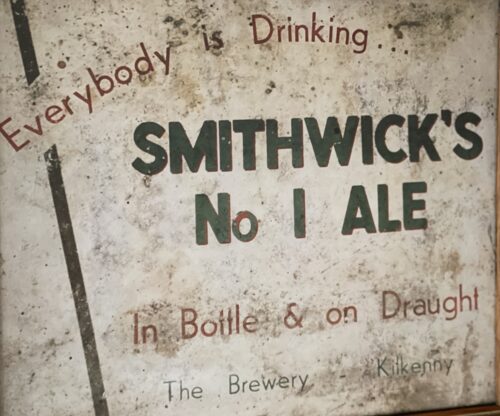
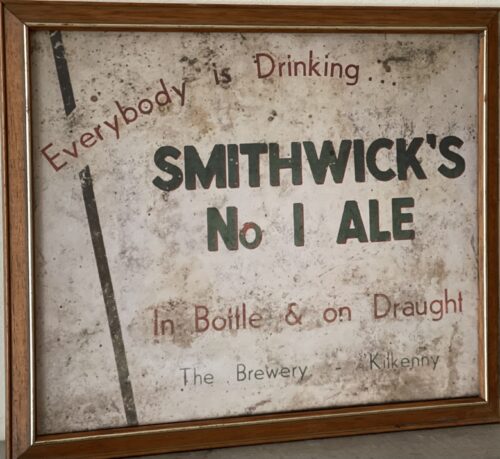 40cm x 34cm LimerickThe old Smithwicks brewery is on the site of a Franciscan abbey, where monks had brewed ale since the 14th century, and ruins of the original abbey still remain on its grounds. The old brewery has since been renovated and now hosts "The Smithwick's Experience Kilkenny" visitor attraction and centre.At the time of its closure, it was Ireland's oldest operating brewery. John Smithwick was an orphan who had settled in Kilkenny. Shortly after his arrival, Smithwick went into the brewing business with Richard Cole on a piece of land that Cole had leased from the Duke of Ormond in 1705. Five years later, John Smithwick became the owner of the land. The brewery stayed small, servicing a loyal local following while John Smithwick diversified. Following John Smithwick's death, the brewery temporarily fell out of family hands. John Smithwick's great grandson, Edmond bought the brewery land back freehold and worked to reshape its future. Edmond concentrated on discovering new markets and successfully building export trade. Drinkers in England, Scotland and Wales developed a taste for Smithwick's brews and output increased fivefold. As a result of substantial contributions made to St Mary's Cathedral, Edmond became great friends with Irish liberal Daniel O'Connell, who later became godfather to one of his sons. Edmond Smithwick became well known and respected by the people of Kilkenny who elected him town mayor four times. In 1800, export sales began to fall and the brewing industry encountered difficulty. To combat this, the Smithwick family increased production in their maltings, began selling mineral water and delivered butter with the ale from the back of their drays.By 1900, output was at an all-time low and the then owner James Smithwick was advised by auditors to shut the doors of the brewery. Instead, James reduced the range of beers they produced and set out to find new markets. He secured military contracts and soon after saw output increase again. James' son, Walter, took control in 1930 and steered the brewery to success through the hardships of both World War II and increasingly challenging weather conditions.By January 1950, Smithwick's was exporting ale to Boston.Smithwick's was purchased from Walter Smithwick in 1965 by Guinness and is now, along with Guinness, part of Diageo. Together, Guinness & Co. and Smithwick's developed and launched Smithwick's Draught Ale in 1966. By 1979, half a million barrels were sold each year.In 1980, Smithwick's began exporting to France. In 1993, Smithwick's Draught became Canada's leading imported ale.By 2010, Smithwick's continued to be brewed in Dundalk and Kilkenny with tankers sent to Dublin to be kegged for the on trade market. Cans and bottles were packaged by IBC in Belfast.Production in the Kilkenny brewery finished on 31 December 2013 and Smithwicks brands are now produced in the Diageo St.James' Gate brewery in Dublin.The original Kilkenny site was sold to Kilkenny County Council, with a small portion of the site dedicated to the opening of a visitor's centre, the "Smithwick's Experience Kilkenny".
40cm x 34cm LimerickThe old Smithwicks brewery is on the site of a Franciscan abbey, where monks had brewed ale since the 14th century, and ruins of the original abbey still remain on its grounds. The old brewery has since been renovated and now hosts "The Smithwick's Experience Kilkenny" visitor attraction and centre.At the time of its closure, it was Ireland's oldest operating brewery. John Smithwick was an orphan who had settled in Kilkenny. Shortly after his arrival, Smithwick went into the brewing business with Richard Cole on a piece of land that Cole had leased from the Duke of Ormond in 1705. Five years later, John Smithwick became the owner of the land. The brewery stayed small, servicing a loyal local following while John Smithwick diversified. Following John Smithwick's death, the brewery temporarily fell out of family hands. John Smithwick's great grandson, Edmond bought the brewery land back freehold and worked to reshape its future. Edmond concentrated on discovering new markets and successfully building export trade. Drinkers in England, Scotland and Wales developed a taste for Smithwick's brews and output increased fivefold. As a result of substantial contributions made to St Mary's Cathedral, Edmond became great friends with Irish liberal Daniel O'Connell, who later became godfather to one of his sons. Edmond Smithwick became well known and respected by the people of Kilkenny who elected him town mayor four times. In 1800, export sales began to fall and the brewing industry encountered difficulty. To combat this, the Smithwick family increased production in their maltings, began selling mineral water and delivered butter with the ale from the back of their drays.By 1900, output was at an all-time low and the then owner James Smithwick was advised by auditors to shut the doors of the brewery. Instead, James reduced the range of beers they produced and set out to find new markets. He secured military contracts and soon after saw output increase again. James' son, Walter, took control in 1930 and steered the brewery to success through the hardships of both World War II and increasingly challenging weather conditions.By January 1950, Smithwick's was exporting ale to Boston.Smithwick's was purchased from Walter Smithwick in 1965 by Guinness and is now, along with Guinness, part of Diageo. Together, Guinness & Co. and Smithwick's developed and launched Smithwick's Draught Ale in 1966. By 1979, half a million barrels were sold each year.In 1980, Smithwick's began exporting to France. In 1993, Smithwick's Draught became Canada's leading imported ale.By 2010, Smithwick's continued to be brewed in Dundalk and Kilkenny with tankers sent to Dublin to be kegged for the on trade market. Cans and bottles were packaged by IBC in Belfast.Production in the Kilkenny brewery finished on 31 December 2013 and Smithwicks brands are now produced in the Diageo St.James' Gate brewery in Dublin.The original Kilkenny site was sold to Kilkenny County Council, with a small portion of the site dedicated to the opening of a visitor's centre, the "Smithwick's Experience Kilkenny". -
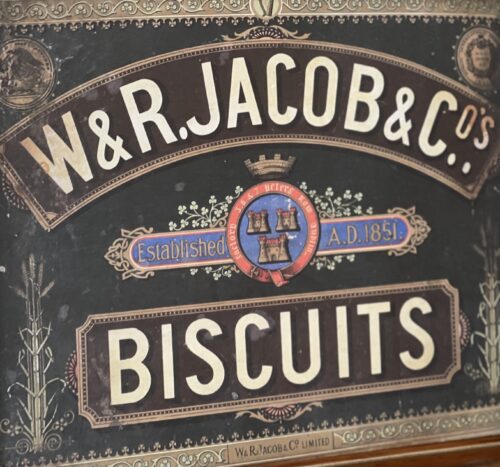
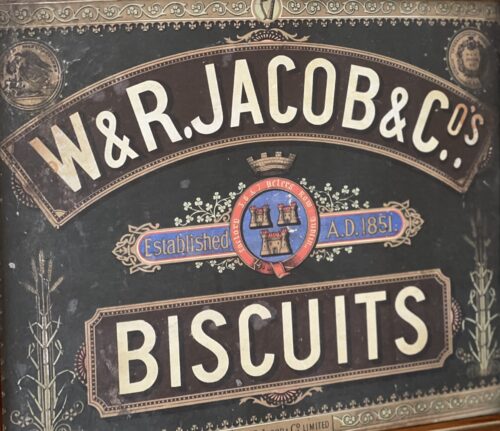 40cm x 34cm LimerickThe biscuit making firm of W. & R. Jacob's were one the largest employers in the Dublin of 1916, and their factory was seized on Easter Monday by perhaps 100 members of the 2nd Battalion of the Dublin Brigade of the Irish Volunteers under Thomas MacDonagh. The factory itself was an enormous and formidable Victorian edifice located on the 'block' enclosed by Bishop St, Bride St, Peter's St and Peter's Row, and between St Patrick's Cathedral and St Stephen's Green. Its seizure helped to complete a loop of building cross the south inner city; the factory had two large towers that could act as observation points, while its location was very close to both Camden St and Patrick St: natural routeways for troops entering the city centre from Portobello Barracks in Rathmines and Wellington Barracks on the South Circular Road. There were only a few staff present in the building when the Volunteers broke into it; a number of smaller outposts were established in the area around the factory. While the garrison saw some fighting early in the week, their principal enemies proved to be boredom and the locals: the factory was surrounded by tenements, and the Volunteers were attacked and abused by residents, many of whom were Jacob's workers themselves. The families of servicemen were also quite hostile, but there may have been another reason for this hostility: Michael O'Hanrahan, who was in Jacob's, expressed his concern that the choice of location might endanger local residents if the British chose to attack. As it happens, the factory was largely by-passed, though it was fired upon intermittently throughout the week by troops in Dublin Castle and elsewhere. MacDonagh surrendered in nearby St Patrick's Park on Sunday 30 April; some of the factory was looted after the Volunteers had left. Three members of the Jacob's garrison were executed. Most of the factory was eventually demolished, though fragments of the ground storey and one of the towers are still visible on Bishop St between the DIT campus on Aungier St and the National Archives of Ireland.
40cm x 34cm LimerickThe biscuit making firm of W. & R. Jacob's were one the largest employers in the Dublin of 1916, and their factory was seized on Easter Monday by perhaps 100 members of the 2nd Battalion of the Dublin Brigade of the Irish Volunteers under Thomas MacDonagh. The factory itself was an enormous and formidable Victorian edifice located on the 'block' enclosed by Bishop St, Bride St, Peter's St and Peter's Row, and between St Patrick's Cathedral and St Stephen's Green. Its seizure helped to complete a loop of building cross the south inner city; the factory had two large towers that could act as observation points, while its location was very close to both Camden St and Patrick St: natural routeways for troops entering the city centre from Portobello Barracks in Rathmines and Wellington Barracks on the South Circular Road. There were only a few staff present in the building when the Volunteers broke into it; a number of smaller outposts were established in the area around the factory. While the garrison saw some fighting early in the week, their principal enemies proved to be boredom and the locals: the factory was surrounded by tenements, and the Volunteers were attacked and abused by residents, many of whom were Jacob's workers themselves. The families of servicemen were also quite hostile, but there may have been another reason for this hostility: Michael O'Hanrahan, who was in Jacob's, expressed his concern that the choice of location might endanger local residents if the British chose to attack. As it happens, the factory was largely by-passed, though it was fired upon intermittently throughout the week by troops in Dublin Castle and elsewhere. MacDonagh surrendered in nearby St Patrick's Park on Sunday 30 April; some of the factory was looted after the Volunteers had left. Three members of the Jacob's garrison were executed. Most of the factory was eventually demolished, though fragments of the ground storey and one of the towers are still visible on Bishop St between the DIT campus on Aungier St and the National Archives of Ireland. -

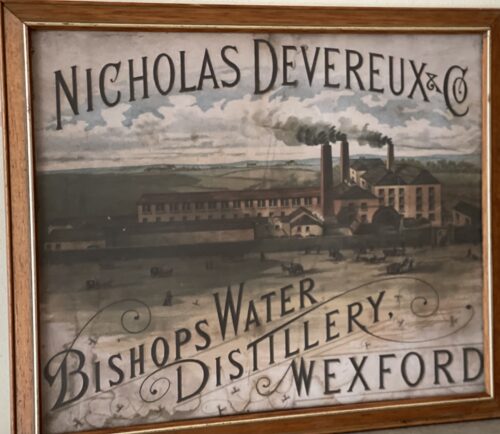 40cm x 34cm LimerickBishops Water Distillery(subsequently known as Nicholas Devereux Finest Irish Whisky) was an Irish whiskey distillery which operated in Wexford, Ireland between 1827 and 1914. The distillery was named for a stream which ran along the back of the distillery, the Bishop's Water, said to possess "various occult properties derived from the blessings of the sainted Bishop of Ferns". Constructed at a cost of £30,000, the distillery was reported to be “reckoned the most perfect and complete of the kind in Ireland”.In 1833, just a few years after it opened, the distillery recorded an output of about 200,000 gallons per annum .However, output had fallen to just 110,000 gallons per annum in 1886, when the distillery was visited by Alfred Barnard, as recorded in his seminal 1887 publication "The Whisky Distilleries of the United Kingdom". This was amongst the lowest output of any distillery operating in Ireland at the time, and far below the potential output of 250,000 gallons per annum reported when the distillery was offered for sale as a going concern in 1909. The distillery's whiskey, Barnard noted, was highly appreciated locally, and in the British cities where it was exported. In the early 20th century, with the Irish whiskey industry in decline, Bishop's Water distillery, like the majority of distilleries in Ireland at the time, suffered serious financial difficulties, and entered bankruptcy. Following its closure, the distillery was initially converted into an iron works (Pierce Ironworks). However, much of the site was later demolished, and little evidence of the distillery still remains. Some mementos can still be found in locals pubs, while a stone archway known to have been extant in 1903 and now bearing the inscription "Casa Rio", possibly in reference to the location of a Pierce ironworks office in Buenos Aires, marks the entrance to the site where the distillery once stood, on Distillery Road. In 1827, a whiskey distillery was established on what is now Distillery Road, Wexford by a consortium of businessmen. The consortium which traded under "Devereux, Harvey, and Co., Distillers", comprised a number of local businessmen, including Nicholas Devereux, his father John Devereux, and Maurice Crosbie Harvey. John Devereux had previously operated a small distillery in the area in the late 1700s, but will little success. In 1830, one of the partners, Maurice Harvey, was accidentally killed at the distillery by an excise man who was taking aim at some birds flying overhead. A few years later, in 1836, the partnership was dissolved at the mutual consent of the remaining partners, with Nicholas Devereux taking sole ownership of the distillery, after which the distillery traded under the name Nicholas Devereux & Son.On his death in 1840, operation of the distillery was taken over by his son Richard. Nichloas Devereux's granddaughter, Mary Anne Therese was also deeply involving in the distilling industry. She married John Locke, founder of the larger Kilbeggan distillery, and successfully took over the business operations of the distillery on his death in 1868. According to Alfred Barnard, the British journalist who visited Bishop's Water in the 1880s, the distillery produced triple-distilled "old pot still whiskey", which was sold locally in Ireland, and also exported to London, Liverpool, and Bristol. At the time of his visit, the Malt Warehouses on-site contained over 16,000 barrels of pure malt. In addition, upwards of 3,000 casks of whiskey were undergoing maturation at the distillery. Whiskey from the distillery is also noted to have been used in the production of blended whiskeys in later years. In the early 20th century, the distillery suffered financial difficulties. In 1907, an attempt was made to appoint a receiver, and in 1909, the distillery was put up for sale, but no takers could be found.In 1914, distilling eventually ceased at the site, and the remaining stocks were sold off.
40cm x 34cm LimerickBishops Water Distillery(subsequently known as Nicholas Devereux Finest Irish Whisky) was an Irish whiskey distillery which operated in Wexford, Ireland between 1827 and 1914. The distillery was named for a stream which ran along the back of the distillery, the Bishop's Water, said to possess "various occult properties derived from the blessings of the sainted Bishop of Ferns". Constructed at a cost of £30,000, the distillery was reported to be “reckoned the most perfect and complete of the kind in Ireland”.In 1833, just a few years after it opened, the distillery recorded an output of about 200,000 gallons per annum .However, output had fallen to just 110,000 gallons per annum in 1886, when the distillery was visited by Alfred Barnard, as recorded in his seminal 1887 publication "The Whisky Distilleries of the United Kingdom". This was amongst the lowest output of any distillery operating in Ireland at the time, and far below the potential output of 250,000 gallons per annum reported when the distillery was offered for sale as a going concern in 1909. The distillery's whiskey, Barnard noted, was highly appreciated locally, and in the British cities where it was exported. In the early 20th century, with the Irish whiskey industry in decline, Bishop's Water distillery, like the majority of distilleries in Ireland at the time, suffered serious financial difficulties, and entered bankruptcy. Following its closure, the distillery was initially converted into an iron works (Pierce Ironworks). However, much of the site was later demolished, and little evidence of the distillery still remains. Some mementos can still be found in locals pubs, while a stone archway known to have been extant in 1903 and now bearing the inscription "Casa Rio", possibly in reference to the location of a Pierce ironworks office in Buenos Aires, marks the entrance to the site where the distillery once stood, on Distillery Road. In 1827, a whiskey distillery was established on what is now Distillery Road, Wexford by a consortium of businessmen. The consortium which traded under "Devereux, Harvey, and Co., Distillers", comprised a number of local businessmen, including Nicholas Devereux, his father John Devereux, and Maurice Crosbie Harvey. John Devereux had previously operated a small distillery in the area in the late 1700s, but will little success. In 1830, one of the partners, Maurice Harvey, was accidentally killed at the distillery by an excise man who was taking aim at some birds flying overhead. A few years later, in 1836, the partnership was dissolved at the mutual consent of the remaining partners, with Nicholas Devereux taking sole ownership of the distillery, after which the distillery traded under the name Nicholas Devereux & Son.On his death in 1840, operation of the distillery was taken over by his son Richard. Nichloas Devereux's granddaughter, Mary Anne Therese was also deeply involving in the distilling industry. She married John Locke, founder of the larger Kilbeggan distillery, and successfully took over the business operations of the distillery on his death in 1868. According to Alfred Barnard, the British journalist who visited Bishop's Water in the 1880s, the distillery produced triple-distilled "old pot still whiskey", which was sold locally in Ireland, and also exported to London, Liverpool, and Bristol. At the time of his visit, the Malt Warehouses on-site contained over 16,000 barrels of pure malt. In addition, upwards of 3,000 casks of whiskey were undergoing maturation at the distillery. Whiskey from the distillery is also noted to have been used in the production of blended whiskeys in later years. In the early 20th century, the distillery suffered financial difficulties. In 1907, an attempt was made to appoint a receiver, and in 1909, the distillery was put up for sale, but no takers could be found.In 1914, distilling eventually ceased at the site, and the remaining stocks were sold off. -
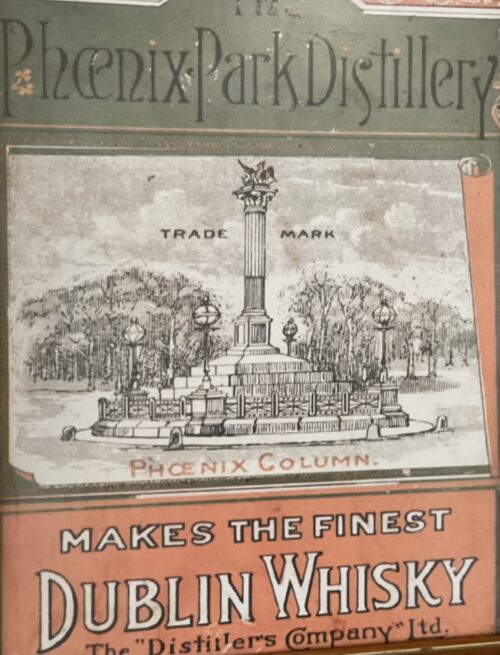
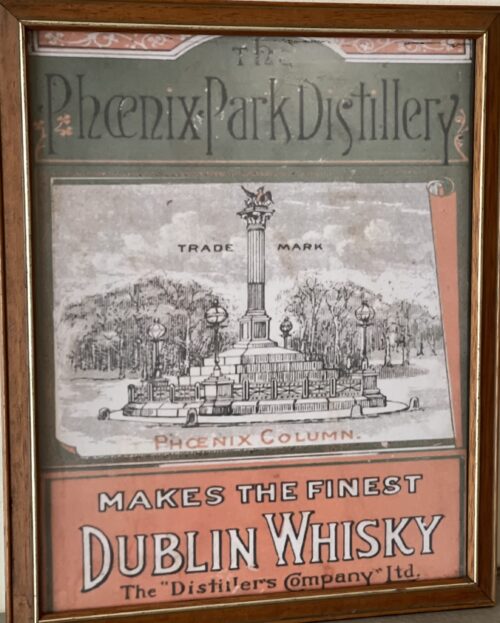 40cm x 34cm Limerick
40cm x 34cm LimerickThe Distillery in Chapelizod, near Dublin's Phoenix Park, was converted from an old mill in 1878 by the Distillers' Company, Ltd., of Scotland, who later went on to become the biggest player in Scotch Whisky owning brands such as Haig, Dewar's, and Buchanan's, as well as countless Malt and Grain Distilleries in Scotland, until the group was taken over by Guinness in the 1980s.
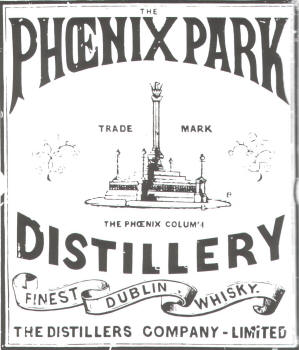 Old Advertisement for Phoenix Park Distillery
Old Advertisement for Phoenix Park DistilleryIt seemed profitable to own an Irish Distillery in those days: Dublin Whiskey, being considered the finest in the world, was priced 25 per cent higher than comparable Scotch Whisky.
The production of Phoenix Park Distillery, 350,000 gallons (1.5 Million Litres) per year, was sold to England and its colonies, as well as used for blending with DCL's own Scottish Malt and Grain Whiskies.
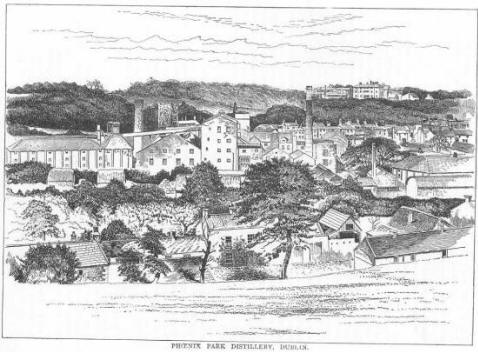 DCL's Phoenix Park Distillery in 1886
DCL's Phoenix Park Distillery in 1886However, Phoenix Park Distillery had only a short life span. Production ceased in 1921, and DCL abandoned the plant a few years later, due to the politically and commercially difficult situation in Ireland at the time.
Today, most buildings have survived, including the mill lade, once holding the largest water wheel in the UK. Others have been converted into apartment houses.
-

 40cm x 34cm LimerickJames Pierce was born in Kilmore in 1813. His father had a forge in the village where he learned his ironwork skills. In 1839 James opened a small foundry specialising in making ‘fire fans’ in Allen Street, Wexford at the age of 26. Eight years later in 1847, he moved to the site previously occupied by the Folly Corn Mill at the junction of Distillery Road and Mill Road. Here he established the ‘Folly Mills Iron Works and Agricultural Machinery and Implement Factory’ (later known as the Mill Road Iron Works). In 1856 James was contracted to build a new bridge over the Slaney linking Carcur and Crosstown to replace the old 1795 Wexford Bridge linking the town and Ferrybank. The bridge was over a quarter of a mile long and remained in use for almost 100 years until 1959 when the new Wexford Bridge was built. The Folly Mills Iron Works also forged the elaborately designed iron railings and gates for the twin churches, completed in 1858. He also built the cast-iron conservatories at Castlebridge House and Edermine House (for Sir James Power of the Power Whiskey family). Pierce’s Foundry was further developed when James’s son Philip (d.1895) joined his father to run the firm. They worked together for just two years until James died in 1868. His other sons Martin (d.1907) and John (d.1926) also joined the business and Pierce’s became the largest agricultural machinery manufacturer in the country with a workforce of 1,000 by 1914. They had offices at Rue de Flandre in Paris and in Rio de Janeiro and their products were shipped all over the world. Two other foundries opened in Wexford at either end of the town. The Star Iron Works was established on reclaimed land off Trinity Street and close to the south railway station. Selskar Iron Works was set up also on reclaimed land opposite the north railway station (the site is now occupied by Dunnes Stores). However, commercial success was interrupted in August 1911 during the infamous ‘Lock-Out’ when the Pierces sought to prevent workers from joining the ITGWU. Soon all of the foundries in the town had followed suit leading to a series of pickets and protests which were not resolved until February of the following year. Pierce’s were exporting horse-drawn farm machinery to Africa and North and South America, Australia and across Europe up until the 1920s. They had offices in Paris and Buenos Aires. In the early 1900s Pierce Bicycle Works operated on the site of the earlier Bishopswater Distillery for about 10 years but without great success. When the old distillery was demolished in the 1940s Pierce’s built housing for employees along the street front (Alvina Brook, 1946). They also built houses for senior managers overlooking the foundry at Avenue de Flandre, Mulgannon Road (1939) and at Casa Rio, Distillery Road (1947) for middle management. Park House (originally Ballyboggan House, built c.1780) was the Pierce family home in the north of the town. However, as the use of tractors became more common, Pierce’s failed to modernise and continued to manufacture for the ‘horse era’. The business inevitably declined and in 1964 the Pierce family sold the business. Pierce Engineering’s last owners, Waterford Stanley, closed the plant in 2002 with the loss of 62 jobs. The site was sold to Tesco who opened their supermarket in 2007. The enormous Pierce’s Foundry site
40cm x 34cm LimerickJames Pierce was born in Kilmore in 1813. His father had a forge in the village where he learned his ironwork skills. In 1839 James opened a small foundry specialising in making ‘fire fans’ in Allen Street, Wexford at the age of 26. Eight years later in 1847, he moved to the site previously occupied by the Folly Corn Mill at the junction of Distillery Road and Mill Road. Here he established the ‘Folly Mills Iron Works and Agricultural Machinery and Implement Factory’ (later known as the Mill Road Iron Works). In 1856 James was contracted to build a new bridge over the Slaney linking Carcur and Crosstown to replace the old 1795 Wexford Bridge linking the town and Ferrybank. The bridge was over a quarter of a mile long and remained in use for almost 100 years until 1959 when the new Wexford Bridge was built. The Folly Mills Iron Works also forged the elaborately designed iron railings and gates for the twin churches, completed in 1858. He also built the cast-iron conservatories at Castlebridge House and Edermine House (for Sir James Power of the Power Whiskey family). Pierce’s Foundry was further developed when James’s son Philip (d.1895) joined his father to run the firm. They worked together for just two years until James died in 1868. His other sons Martin (d.1907) and John (d.1926) also joined the business and Pierce’s became the largest agricultural machinery manufacturer in the country with a workforce of 1,000 by 1914. They had offices at Rue de Flandre in Paris and in Rio de Janeiro and their products were shipped all over the world. Two other foundries opened in Wexford at either end of the town. The Star Iron Works was established on reclaimed land off Trinity Street and close to the south railway station. Selskar Iron Works was set up also on reclaimed land opposite the north railway station (the site is now occupied by Dunnes Stores). However, commercial success was interrupted in August 1911 during the infamous ‘Lock-Out’ when the Pierces sought to prevent workers from joining the ITGWU. Soon all of the foundries in the town had followed suit leading to a series of pickets and protests which were not resolved until February of the following year. Pierce’s were exporting horse-drawn farm machinery to Africa and North and South America, Australia and across Europe up until the 1920s. They had offices in Paris and Buenos Aires. In the early 1900s Pierce Bicycle Works operated on the site of the earlier Bishopswater Distillery for about 10 years but without great success. When the old distillery was demolished in the 1940s Pierce’s built housing for employees along the street front (Alvina Brook, 1946). They also built houses for senior managers overlooking the foundry at Avenue de Flandre, Mulgannon Road (1939) and at Casa Rio, Distillery Road (1947) for middle management. Park House (originally Ballyboggan House, built c.1780) was the Pierce family home in the north of the town. However, as the use of tractors became more common, Pierce’s failed to modernise and continued to manufacture for the ‘horse era’. The business inevitably declined and in 1964 the Pierce family sold the business. Pierce Engineering’s last owners, Waterford Stanley, closed the plant in 2002 with the loss of 62 jobs. The site was sold to Tesco who opened their supermarket in 2007. The enormous Pierce’s Foundry site -

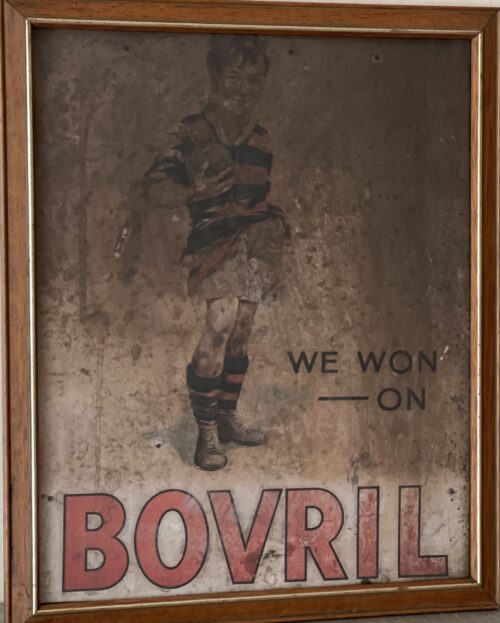 40cm x 34cm LimerickBovril is the trademarked name of a thick and salty meat extract paste similar to a yeast extract, developed in the 1870s by John Lawson Johnston. It is sold in a distinctive bulbous jar, and as cubes and granules. Bovril is owned and distributed by Unilever UK. Its appearance is similar to Marmite and Vegemite. Bovril can be made into a drink ("beef tea") by diluting with hot water or, less commonly, with milk.It can be used as a flavouring for soups, broth, stews or porridge, or as a spread, especially on toast in a similar fashion to Marmite and Vegemite. The first part of the product's name comes from Latin bovīnus, meaning "ox".Johnston took the -vril suffix from Edward Bulwer-Lytton's then-popular novel, The Coming Race (1870), the plot of which revolves around a superior race of people, the Vril-ya, who derive their powers from an electromagnetic substance named "Vril". Therefore, Bovril indicates great strength obtained from an ox.
40cm x 34cm LimerickBovril is the trademarked name of a thick and salty meat extract paste similar to a yeast extract, developed in the 1870s by John Lawson Johnston. It is sold in a distinctive bulbous jar, and as cubes and granules. Bovril is owned and distributed by Unilever UK. Its appearance is similar to Marmite and Vegemite. Bovril can be made into a drink ("beef tea") by diluting with hot water or, less commonly, with milk.It can be used as a flavouring for soups, broth, stews or porridge, or as a spread, especially on toast in a similar fashion to Marmite and Vegemite. The first part of the product's name comes from Latin bovīnus, meaning "ox".Johnston took the -vril suffix from Edward Bulwer-Lytton's then-popular novel, The Coming Race (1870), the plot of which revolves around a superior race of people, the Vril-ya, who derive their powers from an electromagnetic substance named "Vril". Therefore, Bovril indicates great strength obtained from an ox.History
 Poster for Bovril, about 1900; V&A Museum no. E.163-1973In 1870, in the Franco-Prussian War, Napoleon III ordered one million cans of beef to feed his troops. The task of providing this went to John Lawson Johnston, a Scotsman living in Canada. Large quantities of beef were available across the British Dominions and South America, but transport and storage were problematic. Therefore, Johnston created a product known as 'Johnston's Fluid Beef', later called Bovril, to meet Napoleon's needs.By 1888, over 3,000 UK public houses, grocers and dispensing chemists were selling Bovril. In 1889, Bovril Ltd was formed to develop Johnston's business further. During the 1900 Siege of Ladysmith in the Second Boer War, a Bovril-like paste was produced from horse meat within the garrison. Nicknamed Chevril (a portmanteau of Bovril and cheval, French for horse) it was produced by boiling down horse or mule meat to a jelly paste and serving it as a beef tea-like mixture. In addition, Bovril also produced concentrated, pemmican-like dried beef as part of the British Army emergency field ration during the war. The ration comes in the form of a pocket-sized tin can which contain the beef alongside a dried cocoa. The dried beef can be eaten alone, or mixed with water to create a beef tea. Bovril continued to function as a "war food" in World War I and was frequently mentioned in the 1930 account Not So Quiet: Stepdaughters of War by Helen Zenna Smith. It describes the drink being prepared for the casualties at Mons where "the orderlies were just beginning to make Bovril for the wounded, when the bearers and ambulance wagons were shelled as they were bringing the wounded into the hospital". Bovril beef tea was the only hot drink that Ernest Shackleton's team had when they were marooned on Elephant Island during the 1914-17 Endurance Expedition.[11] A thermos of beef tea was the favoured way to fend off the chill of winter season football matches for generations of British fans; Bovril dissolved in hot water is still sold in stadiums all over the United Kingdom. When John Lawson Johnston died, his son George Lawson Johnston inherited and took over the Bovril business. In 1929, George Lawson Johnston was made Baron Luke, of Pavenham, in the county of Bedford. Bovril's instant beef stock was launched in 1966 and its "King of Beef" range of instant flavours for stews, casseroles and gravy in 1971.In 1971, James Goldsmith's Cavenham Foods acquired the Bovril Company but then sold most of its dairies and South American operations to finance further take-overs. The brand is now owned by Unilever. Bovril holds the unusual distinction of having been advertised with a Pope. An advertising campaign of the early 20th century in Britain depicted Pope Leo XIII seated on his throne, bearing a mug of Bovril. The campaign slogan read: The Two Infallible Powers – The Pope & Bovril.
Poster for Bovril, about 1900; V&A Museum no. E.163-1973In 1870, in the Franco-Prussian War, Napoleon III ordered one million cans of beef to feed his troops. The task of providing this went to John Lawson Johnston, a Scotsman living in Canada. Large quantities of beef were available across the British Dominions and South America, but transport and storage were problematic. Therefore, Johnston created a product known as 'Johnston's Fluid Beef', later called Bovril, to meet Napoleon's needs.By 1888, over 3,000 UK public houses, grocers and dispensing chemists were selling Bovril. In 1889, Bovril Ltd was formed to develop Johnston's business further. During the 1900 Siege of Ladysmith in the Second Boer War, a Bovril-like paste was produced from horse meat within the garrison. Nicknamed Chevril (a portmanteau of Bovril and cheval, French for horse) it was produced by boiling down horse or mule meat to a jelly paste and serving it as a beef tea-like mixture. In addition, Bovril also produced concentrated, pemmican-like dried beef as part of the British Army emergency field ration during the war. The ration comes in the form of a pocket-sized tin can which contain the beef alongside a dried cocoa. The dried beef can be eaten alone, or mixed with water to create a beef tea. Bovril continued to function as a "war food" in World War I and was frequently mentioned in the 1930 account Not So Quiet: Stepdaughters of War by Helen Zenna Smith. It describes the drink being prepared for the casualties at Mons where "the orderlies were just beginning to make Bovril for the wounded, when the bearers and ambulance wagons were shelled as they were bringing the wounded into the hospital". Bovril beef tea was the only hot drink that Ernest Shackleton's team had when they were marooned on Elephant Island during the 1914-17 Endurance Expedition.[11] A thermos of beef tea was the favoured way to fend off the chill of winter season football matches for generations of British fans; Bovril dissolved in hot water is still sold in stadiums all over the United Kingdom. When John Lawson Johnston died, his son George Lawson Johnston inherited and took over the Bovril business. In 1929, George Lawson Johnston was made Baron Luke, of Pavenham, in the county of Bedford. Bovril's instant beef stock was launched in 1966 and its "King of Beef" range of instant flavours for stews, casseroles and gravy in 1971.In 1971, James Goldsmith's Cavenham Foods acquired the Bovril Company but then sold most of its dairies and South American operations to finance further take-overs. The brand is now owned by Unilever. Bovril holds the unusual distinction of having been advertised with a Pope. An advertising campaign of the early 20th century in Britain depicted Pope Leo XIII seated on his throne, bearing a mug of Bovril. The campaign slogan read: The Two Infallible Powers – The Pope & Bovril.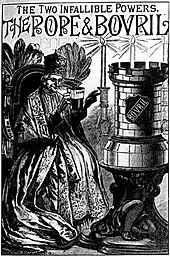 "The Two Infallible Powers: The Pope & Bovril"; poster for Bovril, c. 1900
"The Two Infallible Powers: The Pope & Bovril"; poster for Bovril, c. 1900 -
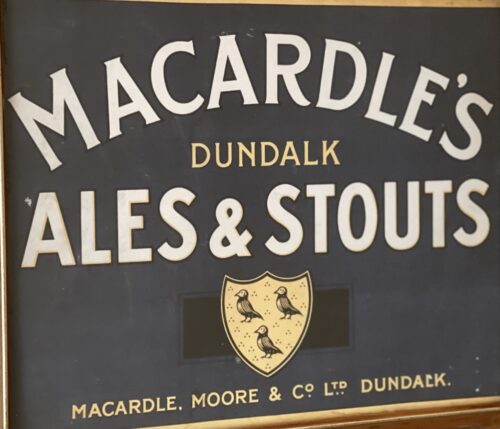
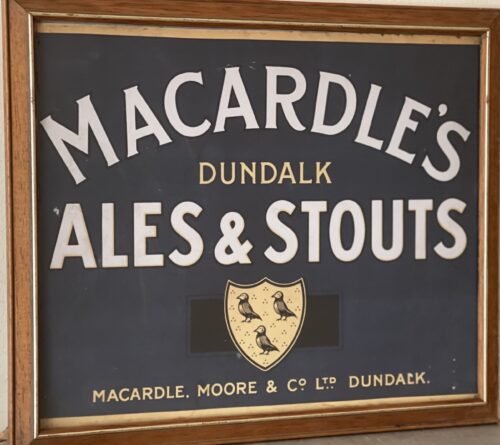 40cm x 34cm Limerick MacArdle Moore Brewery was a brewery in Dundalk, Ireland, formed in 1850 from the merger of two older breweries, McAllisters and Wynnes. Over the years it was to become almost synonymous with brewing in Dundalk. It joined the Guinness empire in the late 1960s. It gave its name to MacArdle's Traditional Ale, an Irish red ale, which is still produced by Diageo, at their St. James's Gate facility in Dublin. It was announced in 2000 that the brewery and a packing facility on the site were to be closed.Brewing resumed on the site by the beverages division of Alltech in 2018, with the move of their brewing from Newry
40cm x 34cm Limerick MacArdle Moore Brewery was a brewery in Dundalk, Ireland, formed in 1850 from the merger of two older breweries, McAllisters and Wynnes. Over the years it was to become almost synonymous with brewing in Dundalk. It joined the Guinness empire in the late 1960s. It gave its name to MacArdle's Traditional Ale, an Irish red ale, which is still produced by Diageo, at their St. James's Gate facility in Dublin. It was announced in 2000 that the brewery and a packing facility on the site were to be closed.Brewing resumed on the site by the beverages division of Alltech in 2018, with the move of their brewing from Newry -

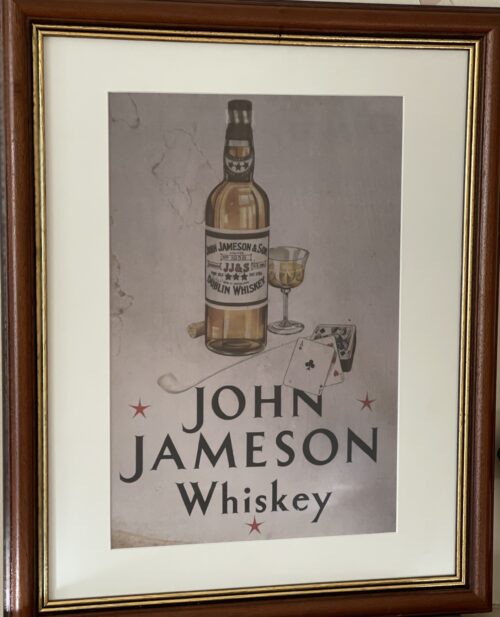 60cm x 50cm Limerick John Jameson was originally a lawyer from Alloa in Scotland before he founded his eponymous distillery in Dublin in 1780.Prevoius to this he had made the wise move of marrying Margaret Haig (1753–1815) in 1768,one of the simple reasons being Margaret was the eldest daughter of John Haig, the famous whisky distiller in Scotland. John and Margaret had eight sons and eight daughters, a family of 16 children. Portraits of the couple by Sir Henry Raeburn are on display in the National Gallery of Ireland. John Jameson joined the Convivial Lodge No. 202, of the Dublin Freemasons on the 24th June 1774 and in 1780, Irish whiskey distillation began at Bow Street. In 1805, he was joined by his son John Jameson II who took over the family business that year and for the next 41 years, John Jameson II built up the business before handing over to his son John Jameson the 3rd in 1851. In 1901, the Company was formally incorporated as John Jameson and Son Ltd. Four of John Jameson’s sons followed his footsteps in distilling in Ireland, John Jameson II (1773 – 1851) at Bow Street, William and James Jameson at Marrowbone Lane in Dublin (where they partnered their Stein relations, calling their business Jameson and Stein, before settling on William Jameson & Co.). The fourth of Jameson's sons, Andrew, who had a small distillery at Enniscorthy, Co. Wexford, was the grandfather of Guglielmo Marconi, inventor of wireless telegraphy. Marconi’s mother was Annie Jameson, Andrew’s daughter. John Jameson’s eldest son, Robert took over his father’s legal business in Alloa. The Jamesons became the most important distilling family in Ireland, despite rivalry between the Bow Street and Marrowbone Lane distilleries. By the turn of the 19th century, it was the second largest producer in Ireland and one of the largest in the world, producing 1,000,000 gallons annually. Dublin at the time was the centre of world whiskey production. It was the second most popular spirit in the world after rum and internationally Jameson had by 1805 become the world's number one whiskey. Today, Jameson is the world's third largest single-distillery whiskey. Historical events, for a time, set the company back. The temperance movement in Ireland had an enormous impact domestically but the two key events that affected Jameson were the Irish War of Independence and subsequent trade war with the British which denied Jameson the export markets of the Commonwealth, and shortly thereafter, the introduction of prohibition in the United States. While Scottish brands could easily slip across the Canada–US border, Jameson was excluded from its biggest market for many years. The introduction of column stills by the Scottish blenders in the mid-19th-century enabled increased production that the Irish, still making labour-intensive single pot still whiskey, could not compete with. There was a legal enquiry somewhere in 1908 to deal with the trade definition of whiskey. The Scottish producers won within some jurisdictions, and blends became recognised in the law of that jurisdiction as whiskey. The Irish in general, and Jameson in particular, continued with the traditional pot still production process for many years.In 1966 John Jameson merged with Cork Distillers and John Powers to form the Irish Distillers Group. In 1976, the Dublin whiskey distilleries of Jameson in Bow Street and in John's Lane were closed following the opening of a New Midleton Distillery by Irish Distillers outside Cork. The Midleton Distillery now produces much of the Irish whiskey sold in Ireland under the Jameson, Midleton, Powers, Redbreast, Spot and Paddy labels. The new facility adjoins the Old Midleton Distillery, the original home of the Paddy label, which is now home to the Jameson Experience Visitor Centre and the Irish Whiskey Academy. The Jameson brand was acquired by the French drinks conglomerate Pernod Ricard in 1988, when it bought Irish Distillers. The old Jameson Distillery in Bow Street near Smithfield in Dublin now serves as a museum which offers tours and tastings. The distillery, which is historical in nature and no longer produces whiskey on site, went through a $12.6 million renovation that was concluded in March 2016, and is now a focal part of Ireland's strategy to raise the number of whiskey tourists, which stood at 600,000 in 2017.Bow Street also now has a fully functioning Maturation Warehouse within its walls since the 2016 renovation. It is here that Jameson 18 Bow Street is finished before being bottled at Cask Strength. In 2008, The Local, an Irish pub in Minneapolis, sold 671 cases of Jameson (22 bottles a day),making it the largest server of Jameson's in the world – a title it maintained for four consecutive years.
60cm x 50cm Limerick John Jameson was originally a lawyer from Alloa in Scotland before he founded his eponymous distillery in Dublin in 1780.Prevoius to this he had made the wise move of marrying Margaret Haig (1753–1815) in 1768,one of the simple reasons being Margaret was the eldest daughter of John Haig, the famous whisky distiller in Scotland. John and Margaret had eight sons and eight daughters, a family of 16 children. Portraits of the couple by Sir Henry Raeburn are on display in the National Gallery of Ireland. John Jameson joined the Convivial Lodge No. 202, of the Dublin Freemasons on the 24th June 1774 and in 1780, Irish whiskey distillation began at Bow Street. In 1805, he was joined by his son John Jameson II who took over the family business that year and for the next 41 years, John Jameson II built up the business before handing over to his son John Jameson the 3rd in 1851. In 1901, the Company was formally incorporated as John Jameson and Son Ltd. Four of John Jameson’s sons followed his footsteps in distilling in Ireland, John Jameson II (1773 – 1851) at Bow Street, William and James Jameson at Marrowbone Lane in Dublin (where they partnered their Stein relations, calling their business Jameson and Stein, before settling on William Jameson & Co.). The fourth of Jameson's sons, Andrew, who had a small distillery at Enniscorthy, Co. Wexford, was the grandfather of Guglielmo Marconi, inventor of wireless telegraphy. Marconi’s mother was Annie Jameson, Andrew’s daughter. John Jameson’s eldest son, Robert took over his father’s legal business in Alloa. The Jamesons became the most important distilling family in Ireland, despite rivalry between the Bow Street and Marrowbone Lane distilleries. By the turn of the 19th century, it was the second largest producer in Ireland and one of the largest in the world, producing 1,000,000 gallons annually. Dublin at the time was the centre of world whiskey production. It was the second most popular spirit in the world after rum and internationally Jameson had by 1805 become the world's number one whiskey. Today, Jameson is the world's third largest single-distillery whiskey. Historical events, for a time, set the company back. The temperance movement in Ireland had an enormous impact domestically but the two key events that affected Jameson were the Irish War of Independence and subsequent trade war with the British which denied Jameson the export markets of the Commonwealth, and shortly thereafter, the introduction of prohibition in the United States. While Scottish brands could easily slip across the Canada–US border, Jameson was excluded from its biggest market for many years. The introduction of column stills by the Scottish blenders in the mid-19th-century enabled increased production that the Irish, still making labour-intensive single pot still whiskey, could not compete with. There was a legal enquiry somewhere in 1908 to deal with the trade definition of whiskey. The Scottish producers won within some jurisdictions, and blends became recognised in the law of that jurisdiction as whiskey. The Irish in general, and Jameson in particular, continued with the traditional pot still production process for many years.In 1966 John Jameson merged with Cork Distillers and John Powers to form the Irish Distillers Group. In 1976, the Dublin whiskey distilleries of Jameson in Bow Street and in John's Lane were closed following the opening of a New Midleton Distillery by Irish Distillers outside Cork. The Midleton Distillery now produces much of the Irish whiskey sold in Ireland under the Jameson, Midleton, Powers, Redbreast, Spot and Paddy labels. The new facility adjoins the Old Midleton Distillery, the original home of the Paddy label, which is now home to the Jameson Experience Visitor Centre and the Irish Whiskey Academy. The Jameson brand was acquired by the French drinks conglomerate Pernod Ricard in 1988, when it bought Irish Distillers. The old Jameson Distillery in Bow Street near Smithfield in Dublin now serves as a museum which offers tours and tastings. The distillery, which is historical in nature and no longer produces whiskey on site, went through a $12.6 million renovation that was concluded in March 2016, and is now a focal part of Ireland's strategy to raise the number of whiskey tourists, which stood at 600,000 in 2017.Bow Street also now has a fully functioning Maturation Warehouse within its walls since the 2016 renovation. It is here that Jameson 18 Bow Street is finished before being bottled at Cask Strength. In 2008, The Local, an Irish pub in Minneapolis, sold 671 cases of Jameson (22 bottles a day),making it the largest server of Jameson's in the world – a title it maintained for four consecutive years. -

 60cm x 50cm Limerick
60cm x 50cm Limerick
Paddy is a brand of blended Irish whiskey produced by Irish Distillers, at the Midleton distillery in County Cork, on behalf of Sazerac, a privately held American company. Irish distillers owned the brand until its sale to Sazerac in 2016. As of 2016, Paddy is the fourth largest selling Irish whiskey in the WorldHistory The Cork Distilleries Company was founded in 1867 to merge four existing distilleries in Cork city (the North Mall, the Green, Watercourse Road, and Daly's) under the control of one group.A fifth distillery, the Midleton distillery, joined the group soon after in 1868. In 1882, the company hired a young Corkman called Paddy Flaherty as a salesman. Flaherty travelled the pubs of Cork marketing the company's unwieldy named "Cork Distilleries Company Old Irish Whiskey".His sales techniques (which including free rounds of drinks for customers) were so good, that when publicans ran low on stock they would write the distillery to reorder cases of "Paddy Flaherty's whiskey". In 1912, with his name having become synonymous with the whiskey, the distillery officially renamed the whiskey Paddy Irish Whiskey in his honour. In 1920s and 1930s in Ireland, whiskey was sold in casks from the distillery to wholesalers, who would in turn sell it on to publicans.To prevent fluctuations in quality due to middlemen diluting their casks, Cork Distilleries Company decided to bottle their own whiskey known as Paddy, becoming one of the first to do so. In 1988, following an unsolicited takeover offer by Grand Metropolitan, Irish Distillers approached Pernod Ricard and subsequently became a subsidiary of the French drinks conglomerate, following a friendly takeover bid. In 2016, Pernod Ricard sold the Paddy brand to Sazerac, a privately held American firm for an undisclosed fee. Pernod Ricard stated that the sale was in order "simplify" their portfolio, and allow for more targeted investment in their other Irish whiskey brands, such as Jameson and Powers. At the time of the sale, Paddy was the fourth largest selling Irish whiskey brand in the world, with sales of 200,000 9-litre cases per annum, across 28 countries worldwide. Paddy whiskey is distilled three times and matured in oak casks for up to seven years.Compared with other Irish whiskeys, Paddy has a comparatively low pot still content and a high malt content in its blend. Jim Murray, author of the Whiskey bible, has rated Paddy as "one of the softest of all Ireland's whiskeys".

Introduced 1879, renamed as Paddy in 1912 -

 60cm x 50cm Limerick The Dubliners were quite simply one of the most famous Irish folk bands of all time.Founded in 1962,they enjoyed a 50 year career with the success of the band centred on their two lead singers,Luke Kelly and Ronnie Drew.They garnered massive international acclaim with their lively Irish folk songs,traditional street ballads and instrumentals eventually crossing over to mainstream culture by appearing on Top of the Pops in 1967 with "Seven Drunken Nights" which sold over 250000 singles in the UK alone.Later a number of collaborations with the Pogues saw them enter the UK singles charts again on another 2 occasions.Instrumental in popularising Irish folk music abroad ,they influenced many generations of Irish bands and covers of Irish ballads such as Raglan Road and the Auld Triangle by Luke Kelly and Ronnie Drew tend to be regarded as definitive versions.They also enjoyed a hard drinking and partying image as can be seen by many collaborations with alcohol advertising campaigns etc
60cm x 50cm Limerick The Dubliners were quite simply one of the most famous Irish folk bands of all time.Founded in 1962,they enjoyed a 50 year career with the success of the band centred on their two lead singers,Luke Kelly and Ronnie Drew.They garnered massive international acclaim with their lively Irish folk songs,traditional street ballads and instrumentals eventually crossing over to mainstream culture by appearing on Top of the Pops in 1967 with "Seven Drunken Nights" which sold over 250000 singles in the UK alone.Later a number of collaborations with the Pogues saw them enter the UK singles charts again on another 2 occasions.Instrumental in popularising Irish folk music abroad ,they influenced many generations of Irish bands and covers of Irish ballads such as Raglan Road and the Auld Triangle by Luke Kelly and Ronnie Drew tend to be regarded as definitive versions.They also enjoyed a hard drinking and partying image as can be seen by many collaborations with alcohol advertising campaigns etc -

 40cm x 34cm LimerickUnfashionably – even eccentrically – bred, and strangely marked, he was a two-year-old of exceptional merit, a champion sire and, despite being sub-fertile and retired early from stud duties, he wielded tremendous influence on the breed. A racehorse of blinding speed, though bred to stay extreme distances. A stallion colossus who proved the cornerstone of an everlasting host of equine celebrities from flying machines to Grand National winners. The supreme nonpareil giant of turf history known as The Tetrarch was truly a freak of nature and, in his esteemed trainer’s words, “there will never be his likes again”.THE TETRARCH
40cm x 34cm LimerickUnfashionably – even eccentrically – bred, and strangely marked, he was a two-year-old of exceptional merit, a champion sire and, despite being sub-fertile and retired early from stud duties, he wielded tremendous influence on the breed. A racehorse of blinding speed, though bred to stay extreme distances. A stallion colossus who proved the cornerstone of an everlasting host of equine celebrities from flying machines to Grand National winners. The supreme nonpareil giant of turf history known as The Tetrarch was truly a freak of nature and, in his esteemed trainer’s words, “there will never be his likes again”.THE TETRARCHEarly Years
 Edward "Cub" KennedyBorn in 1911 on April 22nd at Edward “Cub” Kennedy’s Straffan Station Stud in Kildare, not far from where the present Goffs Sales complex is located. The Tetrarch was born chesnut with black “Bend Or spots” (so called after his Derby winning great-grandsire) which later transformed into his famous grey with splotches of white coat, that saddled him with the nickname “The Rocking Horse”. Every grey horse must have at least one grey parent and The Tetrarch inherited his colour from his sire. A direct line of his grey ancestors can be traced, like all grey thoroughbreds, back to one grey stallion in the original Weatherbys Stud Book named Alcocks Arabian, who was born around the turn of the 18th century and had his origins in Syria. When Cub Kennedy hastily arranged liaison of Roi Herode and Vahren in the late spring of 1910, he had been obsessed with the idea of reviving the apparently moribund male line of Herod. Could there be a more aptly named stallion for the job than Roi Herode? It was already nearly three months into the breeding season when Kennedy purchased his new stallion and he had little chance of attracting many outside mares, but he did have a couple due to foal late himself, one being Vahren. Kennedy decided to send the young Tetrarch to the 1912 Doncaster yearling sales and he knew that for make and shape there would be few to match him. Atty Persse duly had to go to 1,300gns to secure the colt for his patron Dermot McCalmont. When his jockey Steve Donoghue first saw him he described The Tetrarch as “a sort of elephant grey with big blotches, as though someone had splashed him with handfuls of wet lime”. However, once his brilliance on the racecourse became apparent, it wasn’t long before “The Rocking Horse” became “The Spotted Wonder”, a name that one hundred years on still resonates with horse racing aficionados around the world.THE TETRARCH
Edward "Cub" KennedyBorn in 1911 on April 22nd at Edward “Cub” Kennedy’s Straffan Station Stud in Kildare, not far from where the present Goffs Sales complex is located. The Tetrarch was born chesnut with black “Bend Or spots” (so called after his Derby winning great-grandsire) which later transformed into his famous grey with splotches of white coat, that saddled him with the nickname “The Rocking Horse”. Every grey horse must have at least one grey parent and The Tetrarch inherited his colour from his sire. A direct line of his grey ancestors can be traced, like all grey thoroughbreds, back to one grey stallion in the original Weatherbys Stud Book named Alcocks Arabian, who was born around the turn of the 18th century and had his origins in Syria. When Cub Kennedy hastily arranged liaison of Roi Herode and Vahren in the late spring of 1910, he had been obsessed with the idea of reviving the apparently moribund male line of Herod. Could there be a more aptly named stallion for the job than Roi Herode? It was already nearly three months into the breeding season when Kennedy purchased his new stallion and he had little chance of attracting many outside mares, but he did have a couple due to foal late himself, one being Vahren. Kennedy decided to send the young Tetrarch to the 1912 Doncaster yearling sales and he knew that for make and shape there would be few to match him. Atty Persse duly had to go to 1,300gns to secure the colt for his patron Dermot McCalmont. When his jockey Steve Donoghue first saw him he described The Tetrarch as “a sort of elephant grey with big blotches, as though someone had splashed him with handfuls of wet lime”. However, once his brilliance on the racecourse became apparent, it wasn’t long before “The Rocking Horse” became “The Spotted Wonder”, a name that one hundred years on still resonates with horse racing aficionados around the world.THE TETRARCHRacing Career
 The Tetrarch winning the Woodcote Stakes at EpsomAt the age of two The Tetrarch had developed into a magnificent individual and was showing phenomenal speed on the gallops. He made his first public appearance in a novice plate at Newmarket on April 17th 1913 – just five days short of his birthday and blew his twenty rivals away to win “in a canter” by 4 lengths. His second appearance was in the Woodcote Stakes at Epsom, traditionally the first six furlong juvenile race of the season, occurred the day before suffragette Emily Davison was fatally injured in the Derby. The Tetrarch took the race in hand rounding Tattenham Corner and won easily by three lengths, according to the British Bloodstock Review, “It was generally agreed that not since the days of Pretty Polly had a two-year-old accomplished a more impressive performance.” The Coventry Stakes at Royal Ascot was next, then run at five furlongs, and The Tetrarch won pulling up “with his mouth open”, his closest competitor trailed in 10 lengths behind. On July 19th to packed stands, he lined up for Britian’s richest two year old race, the National Breeders’ Produce Stakes (now the National Stakes) at Sandown. This was the only time The Tetrarch came close to defeat, scrambling home by a neck conceding 17 lbs to the runner-up. What onlookers didn’t know, as poor visibility obscured the view from the stands, was that The Tetrarch was severely hindered at the start. This is an account from jockey Steve Donoghue’s biography, “As the tapes went up, The Tetrarch got some of them tangled in his mouth, causing him to rear. On coming down he cannoned against another horse and fell to his knees. Although his plight had seemed hopeless, Steve set off in pursuit. The Tetrarch almost lifted him out of the saddle with his supercharged power as he came nearer and near his rivals with every stride”. Just twelve days later The Tetrarch stepped back up in distance to six furlongs at Glorious Goodwood for the Rous Memorial Stakes where he easily accounted for subsequent 1,000 Guineas and Oaks winner Princess Dorrie (in receipt of 13 lbs). He went on winning, the Champion Breeders Foal Stakes at Derby by four lengths, and what transpired to be his swansong in the Champagne Stakes at Doncaster by three lengths, where The Tetrarch treated Stornoway, his only credible rival for two-year-old honours, with contempt. Stornoway had previously won the Gimcrack and Norfolk (now Flying Childers) Stakes. His season was not meant to end there, but on the day before his intended start in the Imperial Produce Stakes at Kempton he struck into his off-fore fetlock joint, and was retired for the season. Crowned the Champion 2yo of 1913 and rated an unprecedented 10 lbs clear his nearest rival – that season’s Middle Park Stakes winner – The Tetrarch is still considered the greatest juvenile runner of all time. This view is backed by noted turf historians Tony Morris and John Randall, who rated the best juveniles of the 20th century in their book A Century of Champions, and have no doubt about which horse was top. Nearest to The Tetrarch, were Tudor Minstrel and The Tetrarch’s own son Tetratema.THE TETRARCH
The Tetrarch winning the Woodcote Stakes at EpsomAt the age of two The Tetrarch had developed into a magnificent individual and was showing phenomenal speed on the gallops. He made his first public appearance in a novice plate at Newmarket on April 17th 1913 – just five days short of his birthday and blew his twenty rivals away to win “in a canter” by 4 lengths. His second appearance was in the Woodcote Stakes at Epsom, traditionally the first six furlong juvenile race of the season, occurred the day before suffragette Emily Davison was fatally injured in the Derby. The Tetrarch took the race in hand rounding Tattenham Corner and won easily by three lengths, according to the British Bloodstock Review, “It was generally agreed that not since the days of Pretty Polly had a two-year-old accomplished a more impressive performance.” The Coventry Stakes at Royal Ascot was next, then run at five furlongs, and The Tetrarch won pulling up “with his mouth open”, his closest competitor trailed in 10 lengths behind. On July 19th to packed stands, he lined up for Britian’s richest two year old race, the National Breeders’ Produce Stakes (now the National Stakes) at Sandown. This was the only time The Tetrarch came close to defeat, scrambling home by a neck conceding 17 lbs to the runner-up. What onlookers didn’t know, as poor visibility obscured the view from the stands, was that The Tetrarch was severely hindered at the start. This is an account from jockey Steve Donoghue’s biography, “As the tapes went up, The Tetrarch got some of them tangled in his mouth, causing him to rear. On coming down he cannoned against another horse and fell to his knees. Although his plight had seemed hopeless, Steve set off in pursuit. The Tetrarch almost lifted him out of the saddle with his supercharged power as he came nearer and near his rivals with every stride”. Just twelve days later The Tetrarch stepped back up in distance to six furlongs at Glorious Goodwood for the Rous Memorial Stakes where he easily accounted for subsequent 1,000 Guineas and Oaks winner Princess Dorrie (in receipt of 13 lbs). He went on winning, the Champion Breeders Foal Stakes at Derby by four lengths, and what transpired to be his swansong in the Champagne Stakes at Doncaster by three lengths, where The Tetrarch treated Stornoway, his only credible rival for two-year-old honours, with contempt. Stornoway had previously won the Gimcrack and Norfolk (now Flying Childers) Stakes. His season was not meant to end there, but on the day before his intended start in the Imperial Produce Stakes at Kempton he struck into his off-fore fetlock joint, and was retired for the season. Crowned the Champion 2yo of 1913 and rated an unprecedented 10 lbs clear his nearest rival – that season’s Middle Park Stakes winner – The Tetrarch is still considered the greatest juvenile runner of all time. This view is backed by noted turf historians Tony Morris and John Randall, who rated the best juveniles of the 20th century in their book A Century of Champions, and have no doubt about which horse was top. Nearest to The Tetrarch, were Tudor Minstrel and The Tetrarch’s own son Tetratema.THE TETRARCHStud Career
 The Tetrarch was retired in 1915 to stand at his specially-built stallion box and covering shed at an initial fee of 300 guineas. However, due to the meditative state he would enter into when presented a mare, his owner eventually described the champion as “monastic in the extreme”. He only got 130 foals altogether, of which 80 were winners, but with such a dearth of opportunity, it is truly remarkable the number of brilliant racehorses The Tetrarch sired. Champion Sire in 1919, with only two crops of racing age, he was third on the list in 1920 and 1923. As might have been expected, a majority of his best progeny were outstanding two-year olds and sprinters such as: Tetratema Champion Sire and Champion Racehorse at 2, 3 & 4 years Winner of 13 races including 2,000 Guineas, Middle Park Stakes, King’s Stand Stakes and July Cup Mumtaz Mahal Champion 2yo Winner of 10 races including the Nunthorpe Stakes, King George Stakes, Champagne Stakes, Queen Mary Stakes and Molecomb Stakes (both by 10 lengths) The Satrap Champion 2yo Winner of 4 races including Chesham Stakes, July Stakes and Richmond Stakes Moti Mahal Champion 2yo Filly Winner of 6 races including the Coronation Stakes Paola Winner of the Cheveley Park Stakes and Coronation Stakes Stefan the Great Champion Broodmare Sire in Great Britain & Ireland Winner of 2 races including the Middle Park Plate
The Tetrarch was retired in 1915 to stand at his specially-built stallion box and covering shed at an initial fee of 300 guineas. However, due to the meditative state he would enter into when presented a mare, his owner eventually described the champion as “monastic in the extreme”. He only got 130 foals altogether, of which 80 were winners, but with such a dearth of opportunity, it is truly remarkable the number of brilliant racehorses The Tetrarch sired. Champion Sire in 1919, with only two crops of racing age, he was third on the list in 1920 and 1923. As might have been expected, a majority of his best progeny were outstanding two-year olds and sprinters such as: Tetratema Champion Sire and Champion Racehorse at 2, 3 & 4 years Winner of 13 races including 2,000 Guineas, Middle Park Stakes, King’s Stand Stakes and July Cup Mumtaz Mahal Champion 2yo Winner of 10 races including the Nunthorpe Stakes, King George Stakes, Champagne Stakes, Queen Mary Stakes and Molecomb Stakes (both by 10 lengths) The Satrap Champion 2yo Winner of 4 races including Chesham Stakes, July Stakes and Richmond Stakes Moti Mahal Champion 2yo Filly Winner of 6 races including the Coronation Stakes Paola Winner of the Cheveley Park Stakes and Coronation Stakes Stefan the Great Champion Broodmare Sire in Great Britain & Ireland Winner of 2 races including the Middle Park Plate Caligula, the St. Leger winner of 1920The Tetrarch was also capable of siring top class winners over longer distances: Snow Maiden Winner of 6 races including the Irish Oaks and 3rd Irish Derby Caligula Winner of 3 races including the St. Leger, Ascot Derby (now King Edward VII Stakes) and 3rd St James’s Palace Stakes Polemarch A leading sire in Argentina with 6 Classic winners Winner of 5 races including the St. Leger, Gimcrack Stakes and 3rd Middle Park Plate Salmon Trout A leading sire in Brazil Winner of 6 races including St. Leger, Princess of Wales’s Stakes, Dewhurst Stakes and 2nd Gold Cup The Tetrarch was also the sire of : Chief Ruler Twice Champion Sire in New Zealand Tractor A leading sire in New Zealand Arch-Gift Sire of Irish 2,000 Guineas winner Double Arch Ethnarch Sire of the ancestresses of Mill Reef and Blushing GroomMumtaz Mahal
Caligula, the St. Leger winner of 1920The Tetrarch was also capable of siring top class winners over longer distances: Snow Maiden Winner of 6 races including the Irish Oaks and 3rd Irish Derby Caligula Winner of 3 races including the St. Leger, Ascot Derby (now King Edward VII Stakes) and 3rd St James’s Palace Stakes Polemarch A leading sire in Argentina with 6 Classic winners Winner of 5 races including the St. Leger, Gimcrack Stakes and 3rd Middle Park Plate Salmon Trout A leading sire in Brazil Winner of 6 races including St. Leger, Princess of Wales’s Stakes, Dewhurst Stakes and 2nd Gold Cup The Tetrarch was also the sire of : Chief Ruler Twice Champion Sire in New Zealand Tractor A leading sire in New Zealand Arch-Gift Sire of Irish 2,000 Guineas winner Double Arch Ethnarch Sire of the ancestresses of Mill Reef and Blushing GroomMumtaz MahalLegacy
 Mumtaz MahalThe Tetrarch’s greatest legacy is undoubtedly through his daughter Mumtaz Mahal, purchased as a yearling for 9,100 guineas – the second highest price ever at the time – for the Aga Khan, such was her brilliant speed, she later became known as “The Flying Filly”. A champion 2yo on the track, she was to become one of the most influential broodmares of the 20th century. Her daughter Mumtaz Begum produced champion racehorse Nashrullah, who was a Champion sire in both Europe and the USA. His sons include Never Say Die, Nashua, Bold Ruler, Never Bend, Grey Sovereign and Red God. Her other efforts include champion 2yo filly Dodoma, who became the 4th dam of Shergar and Sun Princess, the dam of influential sire Royal Charger. Another daughter produced Abernant, champion 2yo and the greatest sprinter of modern times. Mumtaz Mahal best son was the Mirza, winner of the July and Coventry Stakes, who was seized by the Germans during invasion of Normandy in 1940, went on to numerous stakes winners including Skylarking ancestress of important sires Rahy, Singspiel and Devil’s Bag. Her other daughters Mah Mahal and Mah Iran, were also hugely influential. Mah Mahal’s son Mahmoud won the 1936 Derby in record time before being exported to America for stallion duties and becoming Champion Sire. His lasting legacy will be as the broodmare sire of Almahmoud – grandam of Northern Dancer. Her other descendants include French Champion Sire Arctic Tern, American Champion Sire Halo – sire of Japanese Champion Sire Sunday Silence, and Champion Australian and European Sire Danehill. Mah Iran was the second best two-year-old filly of 1941 and became the dam of Migoli, winner of the Prix de l’Arc de Triomphe, Eclipse Stakes, Champion Stakes, and second in the Derby. Migoli’s full-sister, Star of Iran produced the grey filly Petite Etoile, winner of the 1,000 Guineas, Oaks, Sussex Stakes, Champion Stakes and Coronation Cup. She is the fifth dam of Prix de l’Arc de Triomphe winner Zarkava. Other exceptional racehorses that descend directly from Mumtaz Mahal include Fillies’ Triple Crown winner Oh So Sharp, Champion Sprinter and Champion 3yo Habibti and Australian Champions Octagonal and Danewin.THE TETRARCHTetratema
Mumtaz MahalThe Tetrarch’s greatest legacy is undoubtedly through his daughter Mumtaz Mahal, purchased as a yearling for 9,100 guineas – the second highest price ever at the time – for the Aga Khan, such was her brilliant speed, she later became known as “The Flying Filly”. A champion 2yo on the track, she was to become one of the most influential broodmares of the 20th century. Her daughter Mumtaz Begum produced champion racehorse Nashrullah, who was a Champion sire in both Europe and the USA. His sons include Never Say Die, Nashua, Bold Ruler, Never Bend, Grey Sovereign and Red God. Her other efforts include champion 2yo filly Dodoma, who became the 4th dam of Shergar and Sun Princess, the dam of influential sire Royal Charger. Another daughter produced Abernant, champion 2yo and the greatest sprinter of modern times. Mumtaz Mahal best son was the Mirza, winner of the July and Coventry Stakes, who was seized by the Germans during invasion of Normandy in 1940, went on to numerous stakes winners including Skylarking ancestress of important sires Rahy, Singspiel and Devil’s Bag. Her other daughters Mah Mahal and Mah Iran, were also hugely influential. Mah Mahal’s son Mahmoud won the 1936 Derby in record time before being exported to America for stallion duties and becoming Champion Sire. His lasting legacy will be as the broodmare sire of Almahmoud – grandam of Northern Dancer. Her other descendants include French Champion Sire Arctic Tern, American Champion Sire Halo – sire of Japanese Champion Sire Sunday Silence, and Champion Australian and European Sire Danehill. Mah Iran was the second best two-year-old filly of 1941 and became the dam of Migoli, winner of the Prix de l’Arc de Triomphe, Eclipse Stakes, Champion Stakes, and second in the Derby. Migoli’s full-sister, Star of Iran produced the grey filly Petite Etoile, winner of the 1,000 Guineas, Oaks, Sussex Stakes, Champion Stakes and Coronation Cup. She is the fifth dam of Prix de l’Arc de Triomphe winner Zarkava. Other exceptional racehorses that descend directly from Mumtaz Mahal include Fillies’ Triple Crown winner Oh So Sharp, Champion Sprinter and Champion 3yo Habibti and Australian Champions Octagonal and Danewin.THE TETRARCHTetratemaLegacy
 Tetratema, in his paddock at BallylinchBorn at Ballylinch in 1917, Tetratema was a winner of all his twelve starts over sprint distances but also won the 2,000 Guineas for good measure. After an incredible debut in the National Breeders’ Produce Stakes, he took in the Molecomb Stakes, Champagne Stakes, Imperial Produce Plate and Middle Park Stakes on the way to being crowned Champion 2yo. He began his 3yo career as the first grey to win the 2,000 Guineas since 1838, but failed to stay in both the Derby and Eclipse Stakes. Dropping back to sprint distances he won the (now discontinued) Fern Hill Stakes at Royal Ascot and the King George Stakes at Glorious Goodwood, where he accounted for 1,000 Guineas winner and exceptional sprinter Diadem. As a four year old he won the King’s Stand Stakes at Royal Ascot, before taking the July Cup at Newmarket and repeating his win in the King George Stakes. Tetratema made his swansong in the five furlong Snailwell Stakes at Newmarket before retiring to Ballylinch in 1922 at the same initial fee as his sire, 300 guineas.THE TETRARCH
Tetratema, in his paddock at BallylinchBorn at Ballylinch in 1917, Tetratema was a winner of all his twelve starts over sprint distances but also won the 2,000 Guineas for good measure. After an incredible debut in the National Breeders’ Produce Stakes, he took in the Molecomb Stakes, Champagne Stakes, Imperial Produce Plate and Middle Park Stakes on the way to being crowned Champion 2yo. He began his 3yo career as the first grey to win the 2,000 Guineas since 1838, but failed to stay in both the Derby and Eclipse Stakes. Dropping back to sprint distances he won the (now discontinued) Fern Hill Stakes at Royal Ascot and the King George Stakes at Glorious Goodwood, where he accounted for 1,000 Guineas winner and exceptional sprinter Diadem. As a four year old he won the King’s Stand Stakes at Royal Ascot, before taking the July Cup at Newmarket and repeating his win in the King George Stakes. Tetratema made his swansong in the five furlong Snailwell Stakes at Newmarket before retiring to Ballylinch in 1922 at the same initial fee as his sire, 300 guineas.THE TETRARCH Mr. JinksIn 1929, he emulated his sire by becoming Champion Sire – the same year his daughter Tiffin became Champion 2yo and his son Mr. Jinks was the highest rated colt. In all, Tetratema was a top 7 sire on 11 occasions. Tiffin Champion 2yo Winner of the Cheveley Park Stakes and July Cup Mr Jinks Champion 2yo Colt Winner of the July Stakes, 2,000 Guineas and St. James’s Palace Stakes Myrobella Champion 2yo Winner of the Champagne Stakes, King George Stakes and July Cup Foray Champion 2yo Winner of the July Stakes, Champagne Stakes and King’s Stand Stakes Fourth Hand Winner of the Windsor Castle Stakes and Irish 2,000 Guineas Royal Minstrel Winner of the St. James’s Palace Stakes, Cork and Orrey (now Diamond Jubilee) Stakes and Eclipse Stakes Four Course Winner of the July Stakes, Richmond Stakes, Gimcrack Stakes and 1,000 Guineas Theft Five time Champion Sire in Japan Winner of the Windsor Castle Stakes and Jersey Stakes
Mr. JinksIn 1929, he emulated his sire by becoming Champion Sire – the same year his daughter Tiffin became Champion 2yo and his son Mr. Jinks was the highest rated colt. In all, Tetratema was a top 7 sire on 11 occasions. Tiffin Champion 2yo Winner of the Cheveley Park Stakes and July Cup Mr Jinks Champion 2yo Colt Winner of the July Stakes, 2,000 Guineas and St. James’s Palace Stakes Myrobella Champion 2yo Winner of the Champagne Stakes, King George Stakes and July Cup Foray Champion 2yo Winner of the July Stakes, Champagne Stakes and King’s Stand Stakes Fourth Hand Winner of the Windsor Castle Stakes and Irish 2,000 Guineas Royal Minstrel Winner of the St. James’s Palace Stakes, Cork and Orrey (now Diamond Jubilee) Stakes and Eclipse Stakes Four Course Winner of the July Stakes, Richmond Stakes, Gimcrack Stakes and 1,000 Guineas Theft Five time Champion Sire in Japan Winner of the Windsor Castle Stakes and Jersey Stakes











